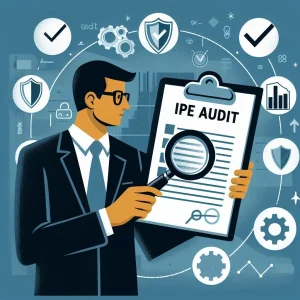In the realm of internal auditing, the concept of audit test of controls is pivotal for ensuring the integrity and reliability of financial reporting. This section aims to elucidate the definition of audit test of controls, contrast traditional approaches with modern risk-focused methodologies, and underscore the significance of control testing in effective risk management.
Audit test of controls refers to the procedures performed by auditors to evaluate the effectiveness of an organization’s internal controls. These tests are designed to determine whether the controls are operating as intended and whether they can effectively mitigate identified risks. By assessing the design and operational effectiveness of these controls, auditors can provide assurance that the financial statements are free from material misstatement due to fraud or error [6][1].
Historically, control testing has often followed a traditional approach, which typically involves a comprehensive review of all internal controls without a specific focus on the associated risks. This method can be resource-intensive and may lead to inefficiencies, particularly in larger organizations where the complexity of operations can obscure the most critical areas of risk. Auditors at smaller firms, in particular, have been hesitant to engage in control testing due to perceived complexities and a lack of adequate client documentation [2][5]. This traditional methodology often results in a one-size-fits-all approach, which may not adequately address the unique risk profiles of different organizations.
Control testing plays a crucial role in risk management by providing insights into the effectiveness of an organization’s internal controls. A robust control testing process allows auditors to identify weaknesses in controls that could lead to significant risks, thereby enabling organizations to take corrective actions before issues escalate. Furthermore, adopting a risk-based approach to control testing allows audit teams to prioritize their efforts on areas with the highest risk exposure, ensuring that resources are allocated efficiently and effectively [10][11]. This shift from traditional methods to a risk-focused testing strategy not only enhances the overall audit process but also strengthens the organization’s risk management framework, ultimately leading to improved compliance and operational efficiency [12][14].
Understanding the audit test of controls and its evolution from traditional to risk-based approaches is essential for risk management professionals and internal auditors. By embracing these modern methodologies, organizations can enhance their internal audit processes, better manage risks, and ensure the reliability of their financial reporting.
Limitations of Traditional Control Testing Methods
In the realm of internal auditing, traditional control testing methods have long been the standard approach for assessing the effectiveness of an organization’s internal controls. However, as the landscape of risk management evolves, it is crucial to recognize the limitations inherent in these conventional methods. Here are some key drawbacks:
- One-Size-Fits-All Approach: Traditional control testing often employs a uniform methodology that does not account for the unique risk profiles of different organizations or departments. This lack of customization can lead to ineffective testing, as it fails to address specific vulnerabilities that may exist within an organization’s operations or financial reporting processes. As a result, auditors may miss critical areas that require focused attention, ultimately compromising the integrity of the audit process [1].
- Inefficiencies and Resource Constraints: Conventional testing methods can be resource-intensive, requiring significant time and personnel to execute. This inefficiency can strain the audit function, particularly in organizations with limited resources. Auditors may find themselves bogged down in extensive testing procedures that do not yield meaningful insights, diverting attention from higher-risk areas that warrant more thorough examination [2]. The traditional approach often leads to a misallocation of resources, where auditors spend excessive time on low-risk controls while neglecting more significant threats.
- Overlooking Critical Risks: One of the most significant drawbacks of traditional control testing is its tendency to overlook critical risks. By adhering strictly to established testing protocols, auditors may fail to adapt their strategies in response to emerging risks or changes in the business environment. This rigidity can result in a false sense of security, as organizations may believe their controls are effective when, in reality, they are not adequately addressing the most pressing risks [3]. The inability to pivot and focus on high-risk areas can lead to material misstatements and compliance failures, undermining the overall effectiveness of the internal audit function.
While traditional control testing methods have served their purpose in the past, their limitations are becoming increasingly apparent in today’s dynamic risk landscape. A shift towards risk-based approaches is essential for internal auditors and risk management professionals to enhance the effectiveness of control testing and ensure that critical risks are adequately addressed.
Understanding Risk-Based Approaches
In the realm of internal auditing, the shift from traditional methods to risk-focused testing has become increasingly vital. This transition is encapsulated in the concept of risk-based auditing, which emphasizes the importance of assessing and prioritizing risks to enhance the effectiveness of control testing. Below, we explore the key elements of risk-based auditing and its significance for internal auditors and risk management professionals.
Definition of Risk-Based Auditing and Its Principles
Risk-based auditing is an approach that prioritizes audit activities based on the assessment of risks associated with an organization’s operations and objectives. The core principles of this methodology include:
- Focus on High-Risk Areas: Resources are allocated to areas with the highest risk, ensuring that the most critical controls are tested thoroughly. This is essential for providing management and the board with confidence in the control testing results, as it allows for a more objective and impartial evaluation of internal controls [1].
- Dynamic Risk Assessment: Risk assessments are not static; they evolve with changes in the business environment, regulatory landscape, and organizational objectives. This adaptability ensures that the audit process remains relevant and effective [10].
- Integration with Business Objectives: Risk-based auditing aligns closely with the organization’s strategic goals, ensuring that the audit process supports overall business objectives and enhances operational effectiveness.
Significance of Risk Assessment in Determining Audit Focus
Risk assessment plays a crucial role in shaping the focus of internal audits. By identifying and evaluating risks, auditors can:
- Prioritize Audit Activities: A thorough risk assessment allows auditors to concentrate on areas that pose the greatest threat to the organization, thereby optimizing the use of limited resources [9].
- Enhance Audit Efficiency: By focusing on high-risk areas, auditors can streamline their processes, reducing the time and effort spent on low-risk controls that may not significantly impact the organization’s financial reporting or operational integrity [11].
- Support Compliance and Risk Management: Effective risk assessment ensures that audits not only meet regulatory requirements but also contribute to the organization’s broader risk management strategies [12].
Alignment of Risk-Based Approaches with Organizational Objectives
The alignment of risk-based auditing with organizational objectives is paramount for achieving meaningful audit outcomes. This alignment is achieved through:
- Understanding Management’s Top Risks: A true risk-based audit approach begins with a comprehensive understanding of the organization’s key risks and business objectives. This understanding informs the audit plan and ensures that audit activities are relevant and impactful [10].
- Proactive Identification of Issues: By integrating risk assessments into the audit process, organizations can identify potential issues early, allowing for timely interventions that can mitigate risks before they escalate [8].
- Continuous Improvement: Risk-based approaches foster a culture of continuous improvement within the organization, as they encourage regular reassessment of risks and controls, ensuring that the audit process evolves alongside the business [9].
Adopting a risk-based approach to control testing in internal auditing not only enhances the effectiveness of audits but also aligns them with the strategic objectives of the organization. By focusing on high-risk areas and integrating risk assessments into the audit process, internal auditors can provide valuable insights that support informed decision-making and robust risk management practices.
Transitioning to Risk-Focused Testing
In the evolving landscape of internal auditing, the shift from traditional methods to risk-focused testing is essential for enhancing the effectiveness of control testing. This transition not only improves audit efficiency but also aligns audit activities with the organization’s most pressing risks. Here are key points to guide internal auditors in making this shift:
Steps to Conduct a Comprehensive Risk Assessment
- Understand Organizational Objectives: Begin by assessing the organization’s strategic goals and objectives. This understanding will help identify the key risks that could impede achieving these objectives.
- Engage Stakeholders: Collaborate with management and other stakeholders to gather insights on perceived risks. This engagement ensures that the risk assessment reflects the organization’s reality and priorities.
- Identify Risks: Utilize various techniques such as interviews, surveys, and workshops to identify potential risks. Consider both internal and external factors that could impact the organization.
- Evaluate Risks: Assess the likelihood and impact of identified risks. This evaluation helps prioritize risks based on their significance to the organization, allowing auditors to focus on the most critical areas.
- Document Findings: Clearly document the risk assessment process and findings. This documentation serves as a reference for audit planning and helps communicate risks to stakeholders effectively.
Selection of Controls Based on Risk Prioritization
- Focus on Key Controls: Once risks are identified and prioritized, select controls that are most relevant to mitigating those risks. This approach ensures that resources are allocated efficiently to areas of highest concern.
- Test Effectiveness: For controls to be deemed effective, they must be tested regularly. Internal auditors should ensure that the selected controls are not only in place but also functioning as intended to mitigate identified risks [5][15].
- Adjust Control Framework: As risks evolve, so should the control framework. Regularly review and adjust the controls in place to ensure they remain effective against the changing risk landscape.
Strategies for Integrating Risk Assessment into Audit Planning
Develop a Risk-Based Audit Plan: Create an audit plan that prioritizes audits based on the results of the risk assessment. This plan should focus on areas with higher risk exposure, ensuring that audit resources are directed where they are needed most [10].
Incorporate Risk Assessment into Audit Tests: When designing audit tests, explicitly link them to the identified risks. This connection ensures that the tests are relevant and address the key risks highlighted in the risk assessment [4][8].
Utilize Technology: Leverage data analytics and other technological tools to enhance risk assessment and control testing. These tools can provide deeper insights into risk patterns and control effectiveness, making the audit process more efficient and effective [12].
Continuous Monitoring: Implement a system for continuous monitoring of risks and controls. This proactive approach allows auditors to identify emerging risks and adjust their testing strategies accordingly, ensuring ongoing relevance and effectiveness of the audit process [11].
By adopting a risk-focused approach to control testing, internal auditors can enhance the reliability of their audits and provide greater assurance to stakeholders. This transition not only aligns audit activities with organizational priorities but also fosters a culture of risk awareness and proactive management within the organization.
Implementing Effective Control Tests
In the realm of internal auditing, the shift from traditional audit methods to a risk-based approach has become increasingly vital. This transition not only enhances the effectiveness of control testing but also aligns audit practices with the dynamic risk landscape organizations face today. Here, we outline various control testing methods, emphasize the importance of continuous monitoring, and highlight the role of technology and data analytics in this process.
Types of Control Testing Methods
Walkthroughs: This method involves tracing a transaction through the entire process to understand how controls operate in practice. Walkthroughs help auditors assess whether controls are designed effectively and are functioning as intended.
Sample Testing: Instead of testing every transaction, auditors select a representative sample to evaluate the effectiveness of controls. This method is efficient and allows auditors to draw conclusions about the entire population based on the sample results.
Inquiry and Observation: Auditors may conduct interviews with personnel and observe processes to gather insights into the effectiveness of controls. This qualitative approach complements quantitative testing methods.
Examination/Inspection: This involves reviewing documents and records to verify that controls are being applied consistently. It is crucial for ensuring that the necessary documentation supports the control processes.
Re-performance: Auditors may independently execute the control procedures to verify their effectiveness. This method provides direct evidence of the control’s operational effectiveness.
Importance of Continuous Monitoring and Adaptation
Continuous monitoring is essential in a risk-based control testing framework. It allows organizations to:
- Identify Emerging Risks: By regularly assessing the control environment, auditors can detect new risks that may arise due to changes in business operations or external factors.
- Adapt Testing Strategies: As risks evolve, so too should the testing strategies. Continuous monitoring enables auditors to adjust their focus and resources to areas of higher risk, ensuring that control tests remain relevant and effective.
- Enhance Responsiveness: A proactive approach to monitoring allows organizations to respond swiftly to control deficiencies, thereby minimizing potential impacts on financial reporting and compliance.
Role of Technology and Data Analytics
The integration of technology and data analytics into control testing has revolutionized the auditing process. Key benefits include:
- Increased Efficiency: Automated testing procedures can significantly reduce the time and effort required for control testing. This efficiency allows auditors to focus on higher-risk areas and strategic insights rather than manual data collection.
- Enhanced Accuracy: Data analytics tools can analyze large volumes of data to identify patterns and anomalies that may indicate control weaknesses. This capability improves the reliability of audit findings.
- Real-Time Insights: Technology enables continuous auditing, where control tests can be performed in real-time. This immediacy allows organizations to address issues as they arise, rather than waiting for periodic audits.
Implementing effective control tests within a risk-based framework requires a comprehensive understanding of various testing methods, a commitment to continuous monitoring, and the strategic use of technology and data analytics. By embracing these elements, internal auditors and risk management professionals can enhance their control testing processes, ultimately leading to more robust risk management and improved organizational resilience.
Challenges in Adopting Risk-Based Approaches
Transitioning from traditional audit methods to risk-based approaches in control testing presents several challenges for internal auditors and risk management professionals. Understanding these barriers is crucial for successful implementation and can help organizations enhance their audit effectiveness. Here are some common challenges and strategies to address them:
Common Barriers to Adopting Risk-Based Approaches
Cultural Resistance: Organizations often have established practices and a culture that may resist change. Employees may be accustomed to traditional methods and skeptical about the benefits of a risk-based approach, leading to reluctance in adopting new processes [2].
Lack of Understanding: There may be a general lack of understanding regarding the principles and benefits of risk-based auditing. This can result in confusion about how to implement these approaches effectively, leading to inconsistent application across the organization [3].
Inadequate Training: Insufficient training and resources can hinder the successful adoption of risk-based methodologies. Internal auditors may not have the necessary skills or knowledge to conduct risk assessments or implement new testing strategies effectively.
Resource Constraints: Organizations may face limitations in terms of time, budget, and personnel, making it difficult to shift focus from traditional methods to a more dynamic risk-based approach. This can lead to prioritization of immediate tasks over long-term strategic changes [5].
Importance of Change Management and Training
Implementing a risk-based approach requires a structured change management strategy. This involves:
- Engaging Stakeholders: Involving key stakeholders early in the process can help build support and understanding of the new approach. This engagement can facilitate smoother transitions and foster a culture of collaboration [2].
- Comprehensive Training Programs: Providing targeted training for internal auditors and relevant staff is essential. Training should cover risk assessment techniques, the rationale behind risk-based approaches, and practical applications to ensure that all team members are equipped to implement these changes effectively.
- Continuous Communication: Maintaining open lines of communication throughout the transition process can help address concerns and clarify expectations. Regular updates and feedback sessions can reinforce the importance of the shift and keep everyone aligned with the organization’s goals [3].
Tips for Overcoming Resistance to Change
Highlight Benefits: Clearly communicate the advantages of risk-based approaches, such as improved efficiency, better resource allocation, and enhanced risk identification. Demonstrating how these methods can lead to more effective audits can help alleviate concerns [2].
Pilot Programs: Implementing pilot programs can provide a practical demonstration of the benefits of risk-based testing. These small-scale initiatives allow organizations to test new methods, gather feedback, and make necessary adjustments before a full rollout [5].
Leadership Support: Gaining support from senior management is crucial. Leaders can champion the change, allocate necessary resources, and help foster a culture that embraces innovation and adaptability.
Celebrate Successes: Recognizing and celebrating early successes in adopting risk-based approaches can motivate teams and reinforce the value of the new methods. Sharing positive outcomes can help build momentum and encourage further adoption across the organization [3].
By addressing these challenges and implementing effective change management strategies, organizations can successfully transition to risk-based approaches in control testing, ultimately enhancing their internal audit processes and risk management capabilities.
Conclusion and Future Directions
In the evolving landscape of internal auditing, the shift from traditional methods to risk-based approaches for control testing is not just a trend but a necessity. This transition offers several benefits that enhance the effectiveness of internal audits and strengthen organizational resilience.
Benefits of Risk-Based Control Testing:
- Risk-based control testing allows auditors to focus their resources on areas of highest risk, ensuring that the most critical aspects of the organization are thoroughly evaluated. This targeted approach not only improves the efficiency of audits but also enhances the quality of insights provided to management, enabling informed decision-making [1][2].
- By fostering a culture of risk awareness, organizations can better align their internal audit activities with their strategic objectives, ultimately leading to improved risk management and control outcomes [7][13].
Encouraging a Proactive Stance:
- As the internal audit profession continues to evolve, it is essential for risk management professionals and internal auditors to adopt a proactive stance towards emerging audit practices. This includes embracing continuous auditing and real-time risk assessments, which can significantly enhance the responsiveness of audit functions to changing risk landscapes [15].
- Organizations should prioritize ongoing training and development for their audit teams to ensure they are equipped with the latest methodologies and tools necessary for effective risk-based auditing [3][12].
Future Trends in Internal Auditing and Risk Management:
- Looking ahead, several trends are likely to shape the future of internal auditing. These include the integration of advanced technologies such as data analytics and artificial intelligence, which can provide deeper insights into risk factors and control effectiveness [10][12].
- Additionally, the emphasis on continuous improvement and adaptability in audit practices will be crucial as organizations navigate increasingly complex regulatory environments and market dynamics [11][14].
In summary, the transition to risk-based control testing represents a significant advancement in the internal audit field. By embracing this approach, organizations can not only enhance their audit effectiveness but also foster a culture of continuous improvement that is essential for navigating the challenges of the future.
Find out more about Shaun Stoltz https://www.shaunstoltz.com/about/
This post was written by an AI and reviewed/edited by a human.



